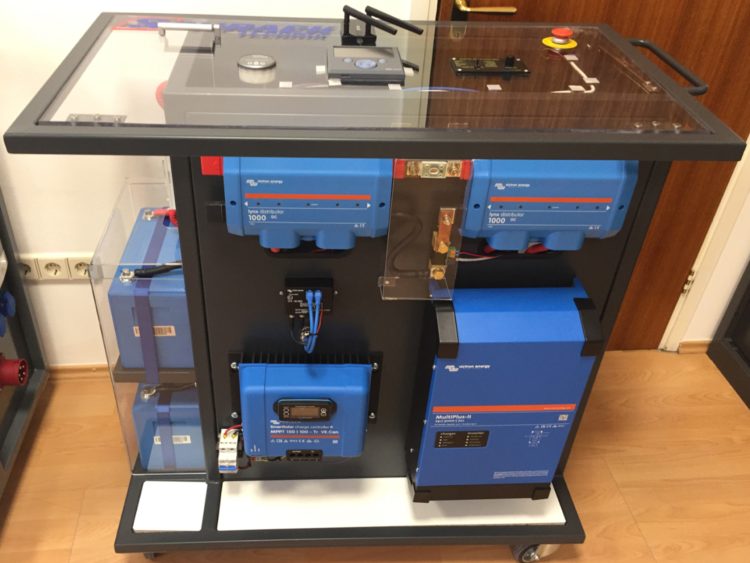
Right across central Europe Schrack Technik provide energy solutions to industry, home and the Electric Vehicle market. They educate customers about the advantages of Solar – and also provide demonstration mobile energy installations for the classroom.
In this article Josip Zdenković (PH.D / M.Sc. E.E.) manager of Schrack Technik, Zagreb, Croatia – tells us what his team is doing to help young people in schools in his region. The idea is to use Schrack employee Dario Jankovic’s M.Sc dissertation to serve as an education for those who follow.
Josip says:
“We are all aware of so called Zero-Energy Buildings through concepts like Passive Houses, Green Building, or Solar Gain. Heat that is not lost does not have to be replaced. This is the key principle of the Passive House Standard and is achieved mostly by means of a well-insulated building envelope, sun shining through the windows, and a ventilation system in which heat from sources such as people and appliances is recovered from the extracted air. The reduced energy demand can be met using renewable energy sources. With regard to the remaining electrical energy requirement, we must control our mains consumption! Photovoltaics and battery storage technology enable that.
“Presenting information about electronics and their features is not such a simple task – even to experienced and educated customers! So how do we present it to students aged 15 to 20, pre-university or college?
“We are certain that this is the latest age at which we can inspire young people to take an interest in the field of renewables. Shall we use the component-to-system or system-to-component approach (bottom upwards or top-down) to lecturing? We decided with students to adopt a top-down strategy.
“Schrack Technik uses a Victron Energy Storage System as the right story for that approach!
Here is the Schrack Technik “top-down” story:
“It’s clear to every student that the best houses can produce its own needs in addition to producing surplus energy for our electrical cars too! Having a good building envelope; upgrading the windows, installing a heat recovery system, what else can we do?
“Today we are using mains electricity as our only energy source. The sun’s energy is at our disposal as a cost-free alternative energy source, but let’s do more. Let’s make it the dominant energy source, keeping mains energy in reserve. How much domestic energy consumption could be provided by the sun is related to power-system dimensioning. Pictured below is the whole system. The house owner should set mains house consumption. Then the actual consumption from the mains is measured. Based on difference between set and actual consumption the consumption controller will pass energy (either direct from sun, or stored from battery) to house loads. So long as there is enough energy from sun, or stored in the battery, house consumption from the mains will be hold on set point. Once there is no sun or there is no more energy stored in battery, the house will be supplied from mains as normal.
“Do you think this is enough simple story for students?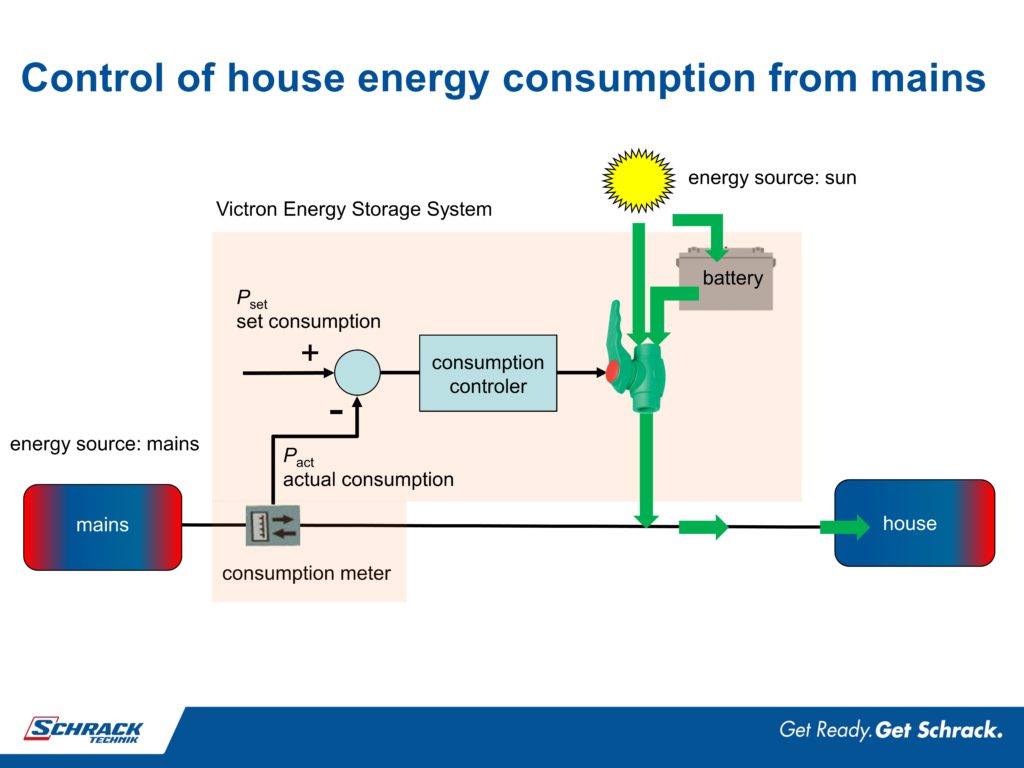
What are the possible ways of converting solar energy into electricity, and how to control energy flow
“In order to achieve the house consumption to stay on set-point, students must understand devices and possible energy flows within those devices. In the picture below both the devices and the possible energy flows are shown. Here we will not go into detail, anyone who is reading this blog is familiar with those devices and their basic operation. Of course for students there should be added some extra words! 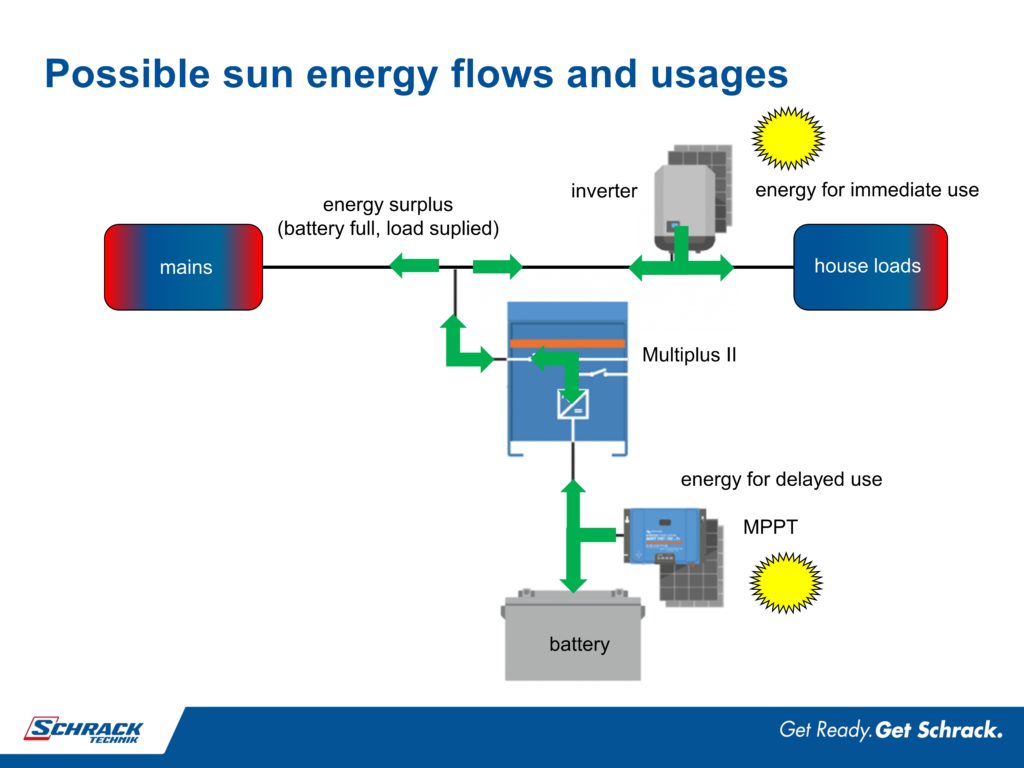
Educational Energy Storage System based on Victron ESS
“For the first set-up Schrack Technik decided to prepare minimal configuration based on Victron ESS which demonstrate the power electronic components, energy flows, and overall strategy to control house consumption from the mains. For the sake of simplicity it was decided not to use a grid inverter for the first model set up, but it can be employed at anytime – the model housing is managed in this way too. Also single phase ESS has been chosen instead of three phase ESS. For educational purposes, single phase ESS is sufficient to show strategy of house mains consumption control!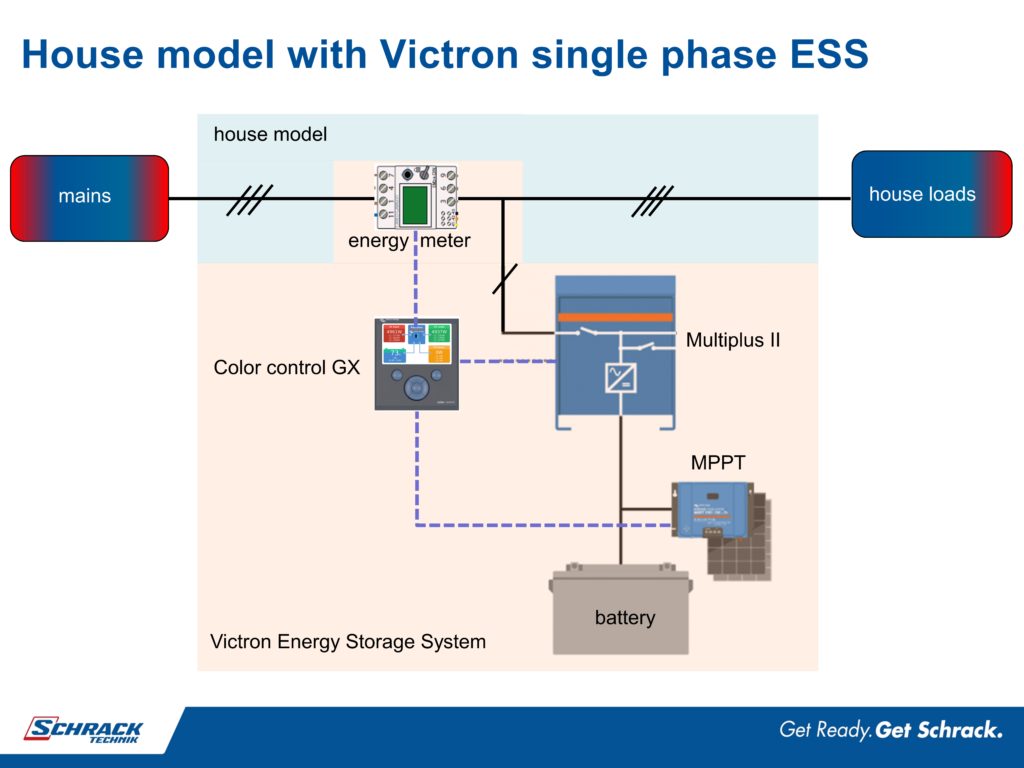
Model set up
“Schrack Technik model set up is designed to be mobile. That simply means it is on wheels so that the model can be taken from classroom to classroom. Each classroom should have a 5 pole mains outlet (L1,L2,L3,N,PE – full TN-C-S connection) to connect mobile set up to the mains electricity.
“This model emulates a typical house load and typical connections. Loads could be connected to all phases and to MultiPlus II output. This set up can demonstrate off-grid systems too. Photovoltaic modules can be connected to the system, or alternatively a power supply (voltage source with current limitation) can be used. This is important because during the lecture it may be cloudy and the PV modules may not be producing electricity. Devices hang on all three sides of the housing, the fourth side is reserved for grid inverter option. Battery monitor, Color control and Digital Multi Control are installed on a glass top – allowing a view to the back side wiring.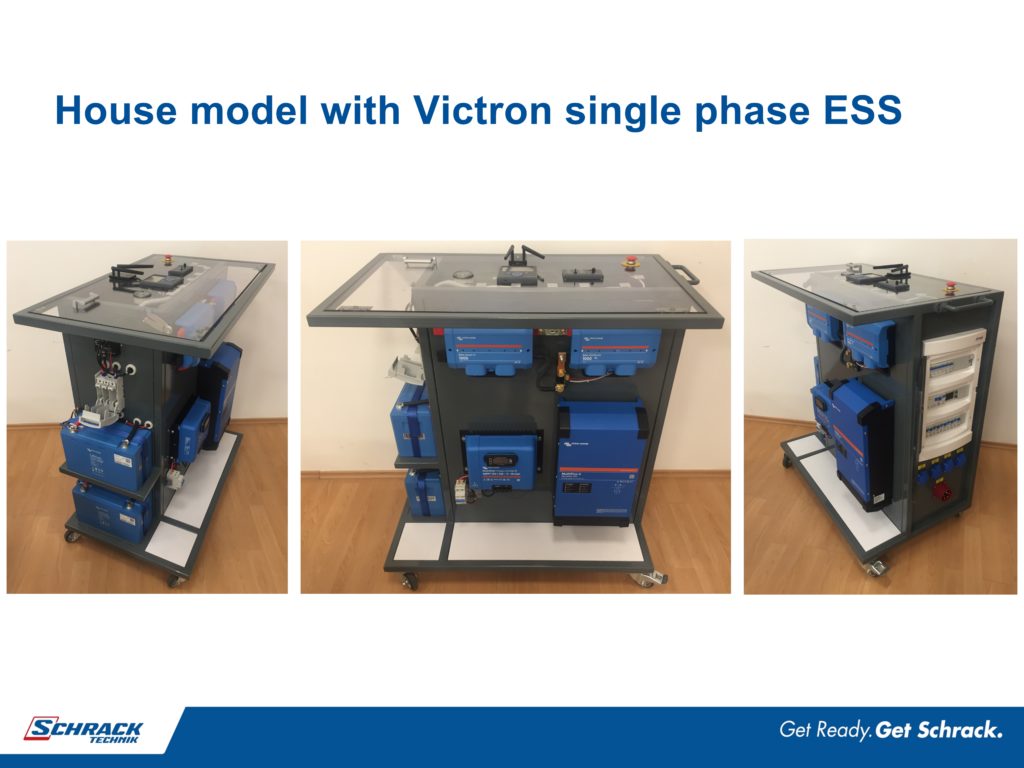
Electrical set up schemes
“The next two schematics show set-up detail: power components and communication components. Atypically, it is the Battery Monitor and the Color Control connection. Supply of these devices is connected after main battery switch …so when the Lithium batteries are switched off no current is drained from them. This is for safety reasons: because the models are mobile they will not permanently be connected to the mains. When not in use the LFP battery should be switched off from any load. What’s inside?:
– SmartSolar MPPT 150/100 VE.Can
– 2 x LiFePO4 Batteries 12,8 V/100 Ah smart
– together with all necessary fuses, switches, protections, cables and covers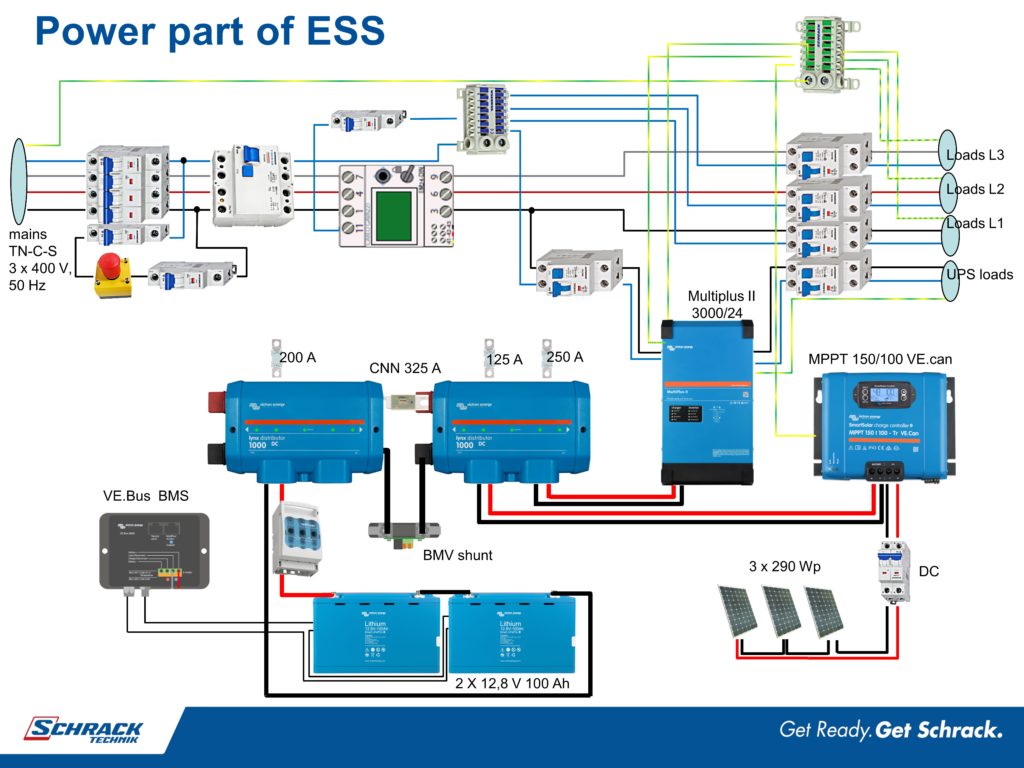
Donation
“Schrack Technik d.o.o. donated a mobile ESS for education to three schools in 2020. There will be three more beneficiaries in 2021. We connect all the teachers involved, so they can exchange experience, working materials and ideas for practical exercises. Schrack Technik trained the teachers – now it is their turn to promote house consumption control to their students. All teachers get administrator access on their installations on the Victron Remote Management (VRM) portal – which allows remote system control and monitoring. Schrack Technik believes that a lot of students will absorb the idea of mains house consumption control. They will learn how simply it can be commissioned and followed on VRM portal and how useful is to control house consumption from mains. Playing with such simple system will enocurage young future installers – freeing of any hesitation about PV installation!
High school Konjščina has 270 students and an electrical engineering department. Course tutors Ivana Smetiško, Dalibor Smetiško, Mario Varga, Milan Havoić invest their own time making sure their students have access to the latest developments. Building a Schrack electrical laboratory – they hope to become a centre of competence in renewables education.
Electro-mechanical vocational school, Selska, has 600 students. Three enthusiastic teachers: Damir Čolig, Ratko Harausek and Mladen Klobučar lecture in renewables. With a focus on mechanical and electrical engineering they demonstrate the application of the science around real-world examples such as motor vehicles.
Technical school, Daruvar, has 474 students whose education is focused on trades and technology. Mario Havranek is the lecturer in renewables, and has a particular interest in Zero-Energy building. He is pleased to be able to offer his students training using the very latest technical equipment.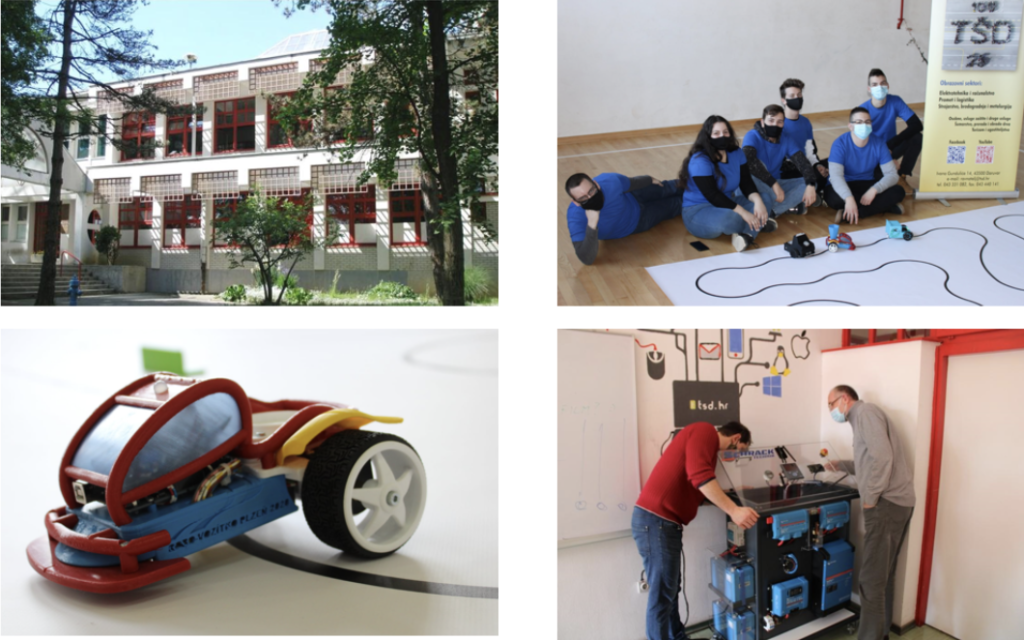
“All students get a copy of the 400 page Schrack Technik brochure showing photovoltaic technology using Victron products, in the main, together with practical examples of Solar installations. Schrack have given away 3000 copies since the programme began 5 years ago.”
And for those who speak Croatian and are keen to learn more about the practical application of Victron products – here is a video lecture which has been put together for students of renewables:






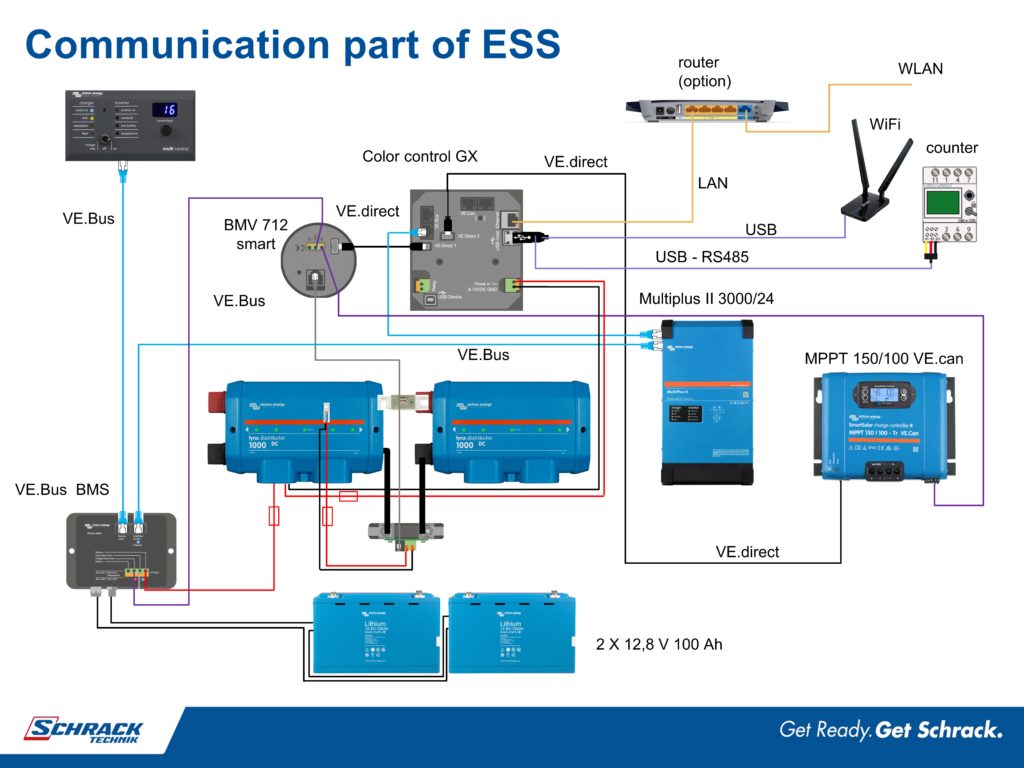
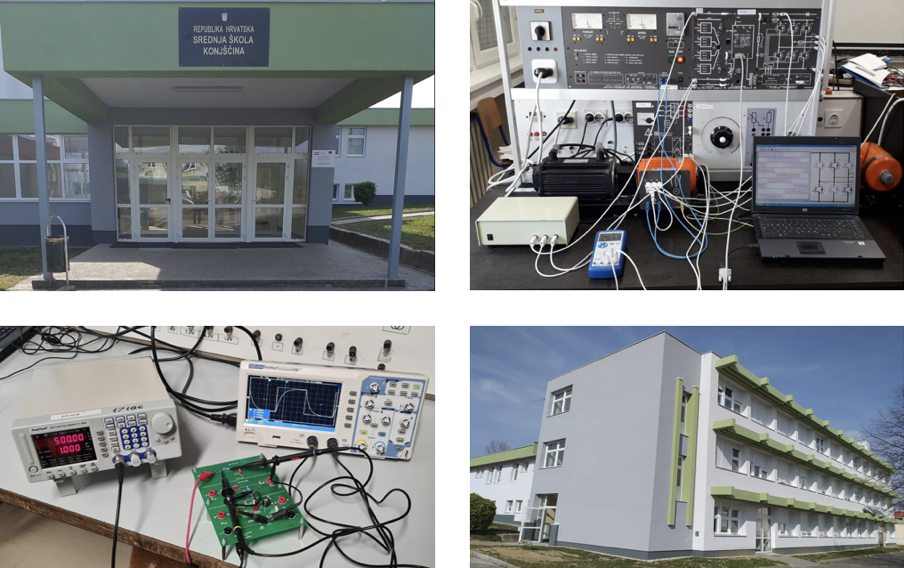
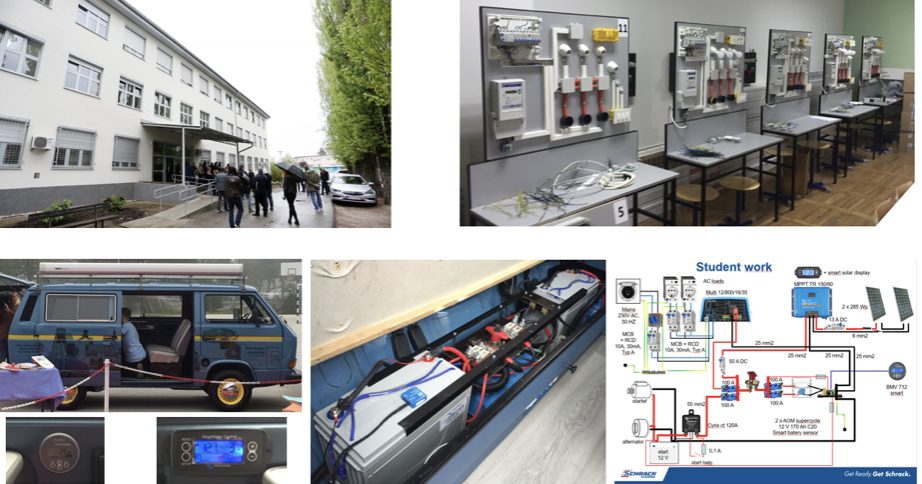












 #victronenergy #adventure
#victronenergy #adventure
 ELECTRICS
ELECTRICS 
